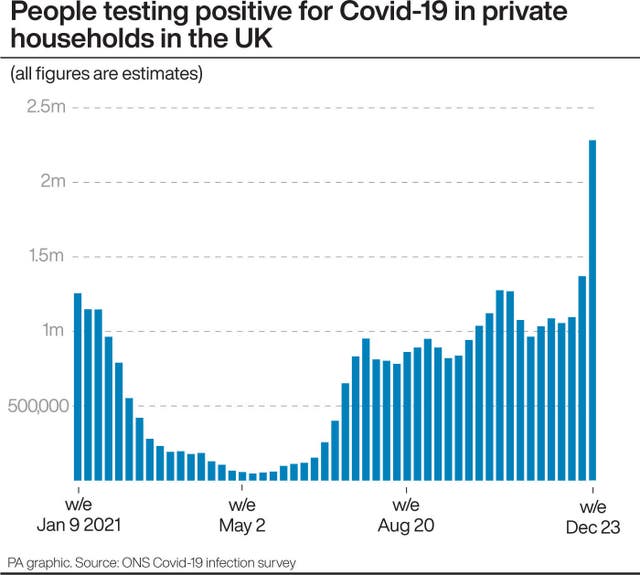Covid-19 infections hit record levels across UK in run-up to Christmas
Around one in 15 people in London are estimated to have had coronavirus last week.

Covid-19 infections hit record levels in all parts of the UK in the run-up to Christmas, new figures show.
An estimated 2.3 million people in private households across the country had Covid-19 in the week ending December 23, up from 1.4 million the previous week.
It is the highest number since comparable figures for the UK began in autumn 2020.

Around one in 25 people in England had Covid-19 last week, up from one in 45 a week earlier, according to the Office for National Statistics (ONS).
In London the figure was one in 15, the highest proportion for any region in England.
Wales, Scotland and Northern Ireland also saw record levels of Covid-19 infections in the week to December 23, with one in 40 people in each nation estimated to have the virus.
All estimates are for people in private households and do not include hospitals, care homes and other settings.
The figures reflect the impact of the Omicron variant of coronavirus on infection levels across the UK in the days leading up to Christmas.
Infections “compatible with Omicron” had “continued to increase rapidly” in all four nations, the ONS said, with Omicron “now the most common variant in England and Scotland”.
When estimating the level of infections among different age groups in England, the ONS said rates were highest for those between the age of two and school year six, and among 25 to 34-year-olds.
But infections among young children were “more likely to be compatible with the Delta variant”, while those among people aged 25 to 34 were more likely to be compatible with Omicron.
The number of Covid-19 infections in the UK, which is estimated every week by the ONS, is not the same as the number of new cases of coronavirus which are reported every day by the Government.
The number of infections provides a snapshot of the prevalence of Covid-19 within the entire community population of the UK, and estimates the percentage of people who are likely to test positive for the virus at any one point – regardless of when they caught the virus, how long they have had it, and whether they have symptoms.
It is based on a sample of swab tests collected from households across the UK.
By contrast, the number of cases of Covid-19 reported each day by the Government includes only those people who have newly tested positive for the virus, and is therefore affected by how many people are coming forward for tests, or who are taking a test because they know they have coronavirus symptoms.





